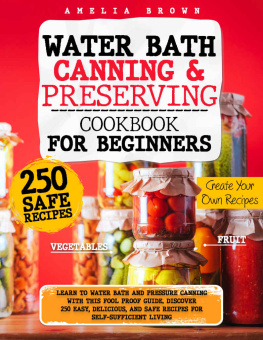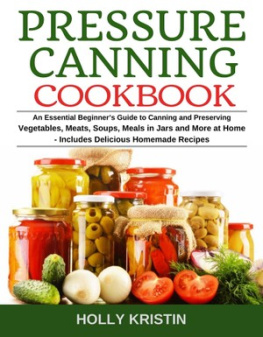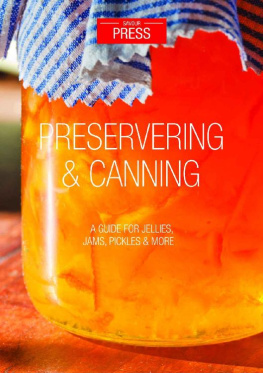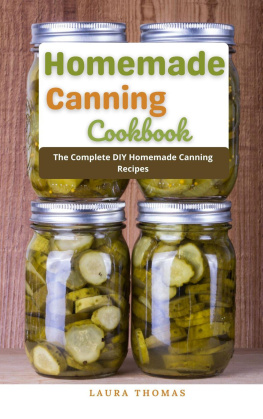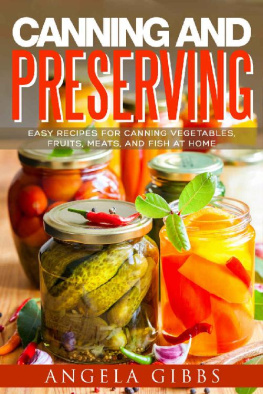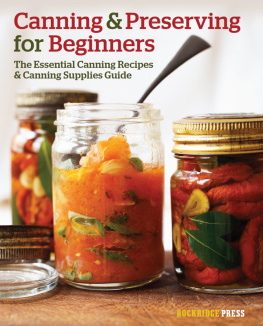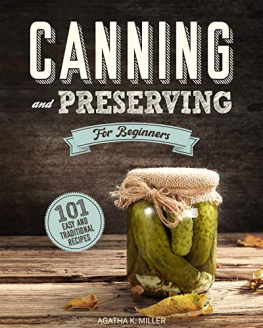The Complete Pressure Canning Guide
Over 250 Easy and Delicious Canning Fruit, Vegetables, Meats Recipes in a Jar, and More
Herren Vitte
Copyright 2021 By Herren Vitte All Rights Reserved
The content contained within this book may not be reproduced, duplicated or transmitted without direct written permission from the author or the publisher.
Under no circumstances will any blame or legal responsibility be held against the publisher, or author, for any damages, reparation, or monetary loss due to the information contained within this book, either directly or indirectly.
Legal Notice:
This book is copyright protected. It is only for personal use. You cannot amend, distribute, sell, use, quote or paraphrase any part of the content within this book, without the consent of the author or publisher.
Disclaimer Notice:
Please note the information contained within this document is for educational and entertainment purposes only. All effort has been executed to present accurate, up to date, reliable, complete information. No warranties of any kind are declared or implied. Readers acknowledge that the author is not engaged in the rendering of legal, financial, medical or professional advice. The content within this book has been derived from various sources. Please consult a licensed professional before attempting any techniques outlined in this book.
By reading this document, the reader agrees that under no circumstances is the author responsible for any losses, direct or indirect, that are incurred as a result of the use of the information contained within this document, including, but not limited to, errors, omissions, or inaccuracies.
Table of Contents
Introduction
Are you curious about pressure canning in order to preserve foods in your own kitchen? Canning is a great way for anyone to preserve foods in their kitchen from their garden. If you grow your own food in a garden or have your own livestock on a farm or homestead, canning is key. By canning fresh produce, you can save money on what it would cost to purchase canned goods from the grocery store. Canning homegrown foods can save you up to half the cost of what store-bought canned goods cost.
Beyond the economic value, when you spend time canning some of your favorite products to later enjoy with friends and family, it can be very satisfying. Many people who venture into the world of canning develop a feeling of pride and fulfillment around the preserved foods in their pantry. With more advanced canning recipes, you can even adjust the contents and flavors to adapt what you make to better satisfy the unique pallets in your household.
After fresh produce is harvested, it begins to lose its nutritional value pretty quickly. If they arent properly cooled or preserved, a few days can cut the number of vitamins or nutrients in half. Even after a few weeks of refrigeration, the nutrients in fresh produce can begin to wane.
Fortunately, through the practice of canning, you can preserve a lot of the vitamins and nutrients found in produce and other foods for years. While some nutritional value can be lost during the heating process and when left in storage for the long-term (Vitamins C and A can diminish), canning as a method of preserving can actually keep most nutrients intact for longer periods of time. The sooner you can get fresh produce in the canner, the more nutrients that are preserved in the process.
Through the course of this canning cookbook, youll learn everything you need to know, from how canning works to what pressure canner you should use. You will also learn plenty of details concerning the right foods to use and the methods you can utilize to maximize your canning experience. By the end of the book, youll have everything you need to begin canning and filling your kitchen with preserved, delicious, and nutritious foods.
Once youre done with the book, pass it along to friends and family so they too can fill their pantries with healthy, preserved foods. Even if they arent growing their own produce, getting high-quality items from grocery stores and farmers markets is a good starting point for canning. So, without further ado, lets begin!
Chapter 1: Overview of Pressure Canning
Before you get immersed in the recipes of pressure canning, there are some key factors to understand and consider. One of the most important parts of pressure canning is in finding the right canner for your needs and your goals. In this chapter, we will cover all the introductory information you need for selecting your canner, and we will also take a look at how canning and preserving works.
We will cover basic terminology and provide you with charts to get yourself started with basic canning for vegetables and meats. Other than the pressure canner, there are some basic canning tools that are required to properly process and prepare food. You can get them in a starter pack. Youll also want to look at buying a variety of mason jars with sealable canning lids. It is a good idea to have different sizes to work with.
Pressure canning is different from your regular canner bath canning. In fact, according to the FDA, anything other than fermented vegetables, like pickles, kimchi, and sauerkraut, and sweet fruit preserves, like jellies, jams, and marmalades, need to be sealed with a pressure canner. Otherwise, it wont hold its seal and can go bad. This means that vegetables, meats, starchy foods like potatoes, and fish/seafood need to be canned with a pressure canner.
The Science Behind Pressure Canning
There are two types of canning, as previously touched on. A commonly used canning method is the canner bath of boiling water. This is often used to can fruit preserves and fermented vegetables. While it is recommended to have a canner bath, some people use nothing more than a large pot for their canner bath.
The second kind of canning, and the focus of this book, is pressure canning. This type requires special equipment, specifically a pressure canner with a weight, a sealable lid, a pressure gauge, and a thermometer. Those who are serious about canning and preserving foods for storage should definitely look into getting themselves a pressure canner setup.
Fresh produce, meats, and other perishable food items are at risk of going bad if not stored at proper temperatures. Even then, meat and produce tend to only have a shelf life of about five to seven days. This is due to the presence and growth of microorganisms.
Microorganisms are fast-growing and live on the surfaces of many foods. Common microorganisms are yeast, mold, and bacteria. If you have food that is bruised, damaged from insect invasion, or came from an unhealthy source like a sick cow, then microorganisms are going to grow much faster.
Food can also go bad due to the activity of food enzymes, the reactions of food with oxygen, and the loss of moisture. You can prolong a foods expiration through refrigeration, keeping in an airtight container, and via other ways as you limit or inhibit these perishing processes.
When you can food for preservation, you remove oxygen, halt enzyme activity, and prevent the growth of microorganisms. The process also seals food in a container designed to keep the microorganisms and air out while also trapping liquids inside.
Pressure canning is used for foods that have low acidity (low pH levels). High-acid foods like citrus, most fruits, and fermented veggies can be properly processed in a canner bath. When you get into meats, dairy, vegetables, and mushrooms, these foods have significantly lower acidity, and a pressure canner is needed to achieve the proper heat and pressure to preserve those foods.
In the case of pressure canning, it isnt the pressure that destroys microorganisms. What kills microorganisms is the steam that is produced in the closed pressure canner, without the influence of any air, applied for a prolonged period of time.



